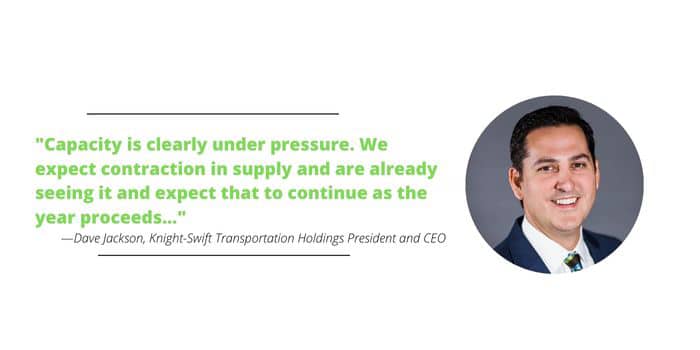The freight market may be cooling down. After a long stretch of port congestion, shipping delays and climbing rates, weakening consumer confidence and growing inventories are contributing to a slowdown in demand.
Ocean shippers and trucking companies alike, looking ahead, are assessing the impact that shifting demand, labor issues, capacity constraints and other issues will have on their businesses.
Promo Angle
In its 2022 second quarter results, freight company C.H. Robinson highlighted that “global economic growth, inflationary pressures, and consumer discretionary spending” all linger as factors its team is following. And for companies in the promo marketplace, these factors will likely affect the freight landscape as they move products during the remainder of 2022 and into 2023.
- Through the rest of this year and into next, companies importing products from overseas are likely to see freight costs and transit times moderate in the direction of historical norms.
- More volatility may be evident when shipping goods within the U.S., as trucking companies wrestle with capacity and other challenges.
Promo companies have been managing supply chain issues for more than a year at this point. A consistent point among most industry companies has been an emphasis on keeping customers informed on how shipping challenges affect their timelines.
At The Ports
In its second quarter financial report, Dutch shipping giant A.P. Moller – Maersk noted that global demand for logistics services has moderated across supply chains. Freight rates softened and container and air cargo volumes declined. The company pointed to geopolitical uncertainty and higher inflation via higher energy prices as weighing on consumer sentiment and growth expectations.
Container rates are also correcting. Drewry, a research and consulting firm serving the shipping industry, reported that its composite World Container Index decreased by 3% to $6,430.07 per 40ft container for the week of August 11.
- The Index has registered 24 consecutive weeks of decreases and is down 32% compared to the same week in 2021.
- Additionally, while higher than the five-year average of $3,613, the Index’s latest rate is 38% below the peak of $10,377, reached in September.
Drewry’s data also shows that transit times and port delays are improving. It found that port congestion in North America has dropped from 20 times the norm in January to a still elevated but more modest 10 times the norm by the middle of the year.
- Transpacific eastbound “best case” transit times—from the last port in Asia to the first port on the West Coast of North America—have shortened from about 34 days in January to 20 days in July.
The Port of Los Angeles recently reported record container traffic. Gene Seroka, the port’s executive director, says, “Halfway through the year, we’ve been able to reduce the number of vessels waiting to berth by 75%, allowing dock workers to efficiently process more vessels. We’re already beginning to handle back-to-school, fall fashion and year-end holiday goods. Despite inflation and higher-than-usual inventory, we expect cargo volume to remain robust the second half of the year.”
Uncertainty
The trucking companies handling the next leg of products’ journey to warehouses and retailers are wrestling with their own challenges as the shipping landscape, economy and consumer sentiment shifts. It was reflected in many of their second quarter financial reports, where a sense of uncertainty was a common aspect of their outlook for the second half of 2022.
In Heartland Express’ second quarter report, CEO Mike Gerdin remarked, “Given what we have experienced and based on feedback from our strong group of customers, we expect volatile freight demand throughout 2022 but at volumes that will continue to exceed our available capacity.”
A similar sentiment was shared by Landstar President and CEO Jim Gattoni.
“There is a lot of unease regarding U.S. economic conditions as we head into the third quarter,” Gattoni says. “On a macroeconomic level, the record low level of consumer confidence and high level of inflation being reported along with possible further action by the Federal Reserve to address inflation at the risk of causing further recessionary pressure all add significant uncertainty to the performance of the overall domestic freight environment.”
The economy is an acute concern as these companies move through the year. Bob Biesterfeld, president and CEO of C.H. Robinson, says, “As we look to the second half of the year, we are watching economic conditions closely, and the management team and board continue to consider all strategies to grow operating profits and maximize long-term shareholder returns through all phases of the business cycle and various economic scenarios.”

Changing consumer sentiment is shifting the supply and demand equation in many markets, and freight companies expect capacity challenges will weight on their second-half outlooks.
“We expect that demand may moderate as the consumer digests and deals with higher inflation and uncertainty in the economy,” says Knight-Swift Transportation Holdings President and CEO Dave Jackson. “We expect continued decline in non-contract truckload opportunities… Capacity is clearly under pressure. We expect contraction in supply and are already seeing it and expect that to continue as the year proceeds as carriers deal with depressed spot rates combined with high energy fuel prices, higher maintenance and equipment costs and rising interest rates, which not only makes it difficult for those that are highly leveraged, but also disincentivizes new entrants to the market.”


